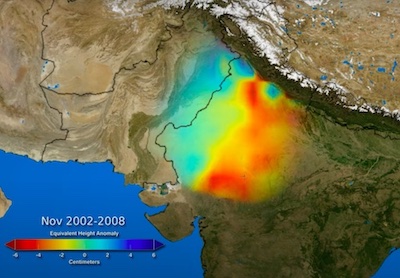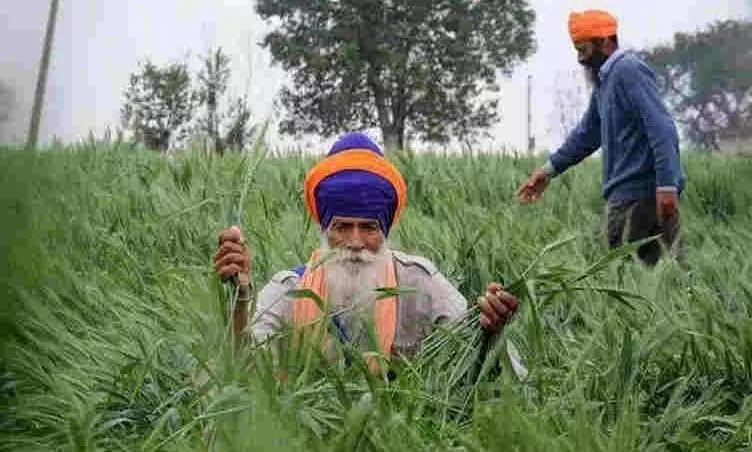Northern part of India, particularly the states of Haryana and Punjab are facing depleting water resource. Numerous studies and reports point towards this alarming situation. Please find below reference links of some of the studies which indicates how difficult situation we are getting into with reference to water. The order in which they are mentioned is random and the references is just few from hundreds of such studies and reports in public domain.

Groundwater Depletion in India Revealed by GRACE
Scientists using data from NASA's Gravity Recovery and Climate Experiment (GRACE) have found that the groundwater beneath Northern India has been receding by as much as one foot per year over the past decade.
https://svs.gsfc.nasa.gov/4134
Karnal’s water table down by over 50 feet in 45 years
(Times of India, 24th Aug’2021)
“The groundwater level has declined at an alarming rate in Haryana. In key agrarian district like Karnal water table has dropped by 16.09 metres in the last 45 years, the data sourced from the groundwater cell of the Karnal agriculture department has revealed. The water table of the district has gone down from 5.72m in 1974 to 21.81m in 2019. The fastest decline started in 1999 when submersible tubewell / pumps (deep tubewells) came into existence. While water was available at 9.08 m in 1999, it settled at 16.67m in 2010.
The Central Ground Water Authority had declared Karnal block as a dark zone, where there are restrictions to install new tubewell connection.”
https://timesofindia.indiatimes.com/
Punjab groundwater level dips 1m every year: Study
(Hindustan Times, 21 Just 2021)
The study, Ground Water Depletion in Punjab, authored by Rajan Aggarwal, Samanpreet Kaur and Anmol Kaur Gill was published by PAU and submitted to the state government last month. The study found that groundwater that was available at three to 10 metres has fallen to below 30 metres in two decades.
https://www.hindustantimes.com/


As groundwater level dips, Punjab farmers look for shift in wheat-paddy cycle
(News9Live, 13 Dec 2021)
Punjab turning desert? Experts have estimated that underground water in about 14.50 billion cubic meter is drawn every year in Punjab to grow paddy and other crops. The US space agency NASA in 2019 said that if the drawing of water continues in the present state, Punjab would become a desert in about three decades.
https://www.news9live.com/
Parched Punjab
(Down To Earth, October 1999)
“In the past two decades, the groundwater table in Punjab has been falling at the rate of 25-30 centimetres (cm) a year, says N S Pasricha of the soil engineering department, PAU. According to a study by Hira, out of the state's area of 5.03 million hectares (ha), 4.32 million ha has a falling water problem. Going by the statistics of the state groundwater department, the area where the water depth has gone below 10 m increased from three per cent in 1973 to 25 per cent in 1990 and 46 per cent by 1994. If the water table goes below 15 m, the tubewells will stop functioning.”
https://www.downtoearth.org.in

A Cancer valley along the Ganga(Feb 2008)
The cancer valley of India lies between Delhi and Patna along the Ganga.
The study, conducted by the International Hepato-Pancreato-Biliary Association (IHPBA) only reaffirms an earlier Indian Council of Medical Research (ICMR) finding that gall bladder cancer among women in north India, including Delhi, was the highest in the world – 10.6 out of every lakh women. The study has concluded that the high rate is due to pollution of the Ganga waters and the soil around with heavy metals like lead, cadmium and chromium.
The project, which screened 22,000 people across 60 villages in the Indo Gangetic belt with the help of Mumbai-based International Institute of Population Sciences (IIPS), found the incidence of cancer in the region was between 12 and 20 for every 1,00,000 people. The corresponding figure for southern India is 0.8 while for Mumbai is 1.2.
Source: Hindustan Times
Weak flow of the Yamuna is unable to evacuate waste
Nitin Kumar, Deputy Chief Executive Officer at Ultra PRT Ltd, UK (Feb 2017)
Discharge of untreated or only partially treated waste water through 22 major drains in the Yamuna river is responsible for the high level of pollution of the river. Six of these drains contribute to almost 90% of the flow and to 80% of the BOD load. Extreme levels of BOD and coliforms make the river dangerous for drinking and bathing. Moreover, because almost all the water has been pumped out upstream for irrigation and for urban uses, except during the monsoon period, the weak flow of the Yamuna is unable to evacuate waste water and polluted silt.
Image and text source:We need to save River Yamuna, Linkedin

Minimum environmental flow for the dilution of polluted water in Yamuna is required to meet the desired water quality levels even for bathing purpose
A study conducted by National Institute of Hydrology, Roorkee, recommended that 23 cubic metres per second (cumec) water should be released in the river from the Hathnikund Barrage in Haryana’s Yamuna Nagar district in the lean season for sustaining downstream ecosystems.
“The National Mission for Clean Ganga observed that the water sharing agreement of 1994 among the riparian states of Uttarakhand, Himachal Pradesh, Uttar Pradesh, Haryana, Rajasthan and Delhi is due for revision in 2025, implying that no revision will be possible to achieve the E-flow in Yamuna,”the report stated. “In the absence of a minimum environmental flow of the Yamuna in Delhi, it is very difficult to achieve bathing quality standards,” it mentioned.
The 22 km stretch of Yamuna from Wazirabad to Okhla in Delhi, which is less than two per cent of the river length, accounts for about 80 per cent of the pollution in the river. Untreated wastewater, poor quality of effluent discharged from Common Effluent Treatment Plants and sewage treatment plants are the major reasons behind pollution in the river, according to expert.
The Delhi government banned the sale, transportation and marketing of detergents which do not meet BIS standards to curb the pollution. The report also stated that out of the 35 sewage treatment plants in Delhi, 22 do not meet the wastewater standards prescribed by the Delhi Pollution Control Committee (DPCC).
Source:The New Indian Express, July, 2021
Yamuna’s pollution starts from Tajewala
Yamuna’s pollution starts from Tajewala in the upper segment. Here two canals, the Western Yamuna Canal (WYC) and the Eastern Yamuna Canal (EYC), divert river waters — save in the three monsoon months — into Haryana and Uttar Pradesh (UP). The WYC crosses Yamuna Nagar, Karnal and Panipat before reaching the Haiderpur treatment plant (which supplies part of Delhi’s water), receiving wastewater from Yamuna Nagar and Panipat.
Source:Rain Water Harvesting